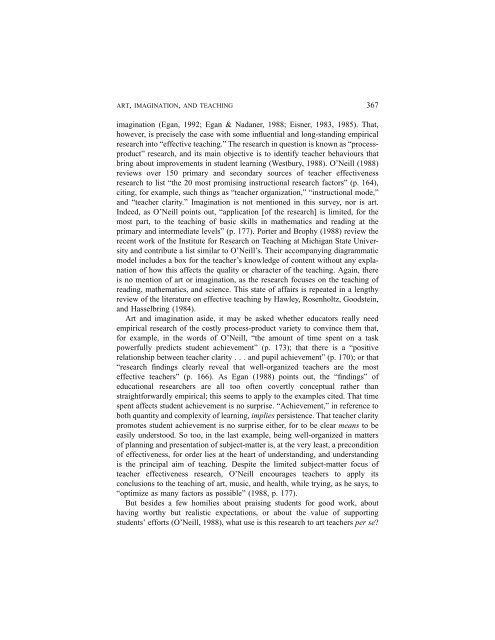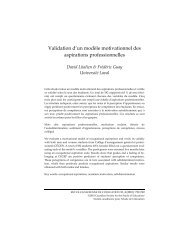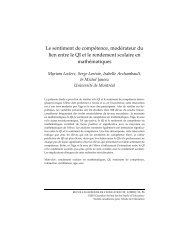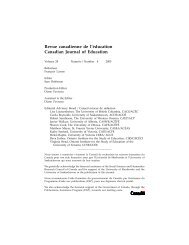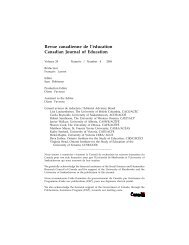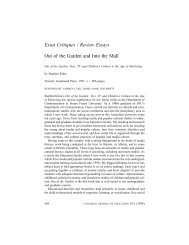Mireille Falardeau et Michel Loranger Le choix de stratégies ... - CSSE
Mireille Falardeau et Michel Loranger Le choix de stratégies ... - CSSE
Mireille Falardeau et Michel Loranger Le choix de stratégies ... - CSSE
Create successful ePaper yourself
Turn your PDF publications into a flip-book with our unique Google optimized e-Paper software.
ART, IMAGINATION, AND TEACHING 367<br />
imagination (Egan, 1992; Egan & Nadaner, 1988; Eisner, 1983, 1985). That,<br />
however, is precisely the case with some influential and long-standing empirical<br />
research into “effective teaching.” The research in question is known as “processproduct”<br />
research, and its main objective is to i<strong>de</strong>ntify teacher behaviours that<br />
bring about improvements in stu<strong>de</strong>nt learning (Westbury, 1988). O’Neill (1988)<br />
reviews over 150 primary and secondary sources of teacher effectiveness<br />
research to list “the 20 most promising instructional research factors” (p. 164),<br />
citing, for example, such things as “teacher organization,” “instructional mo<strong>de</strong>,”<br />
and “teacher clarity.” Imagination is not mentioned in this survey, nor is art.<br />
In<strong>de</strong>ed, as O’Neill points out, “application [of the research] is limited, for the<br />
most part, to the teaching of basic skills in mathematics and reading at the<br />
primary and intermediate levels” (p. 177). Porter and Brophy (1988) review the<br />
recent work of the Institute for Research on Teaching at Michigan State University<br />
and contribute a list similar to O’Neill’s. Their accompanying diagrammatic<br />
mo<strong>de</strong>l inclu<strong>de</strong>s a box for the teacher’s knowledge of content without any explanation<br />
of how this affects the quality or character of the teaching. Again, there<br />
is no mention of art or imagination, as the research focuses on the teaching of<br />
reading, mathematics, and science. This state of affairs is repeated in a lengthy<br />
review of the literature on effective teaching by Hawley, Rosenholtz, Goodstein,<br />
and Hasselbring (1984).<br />
Art and imagination asi<strong>de</strong>, it may be asked wh<strong>et</strong>her educators really need<br />
empirical research of the costly process-product vari<strong>et</strong>y to convince them that,<br />
for example, in the words of O’Neill, “the amount of time spent on a task<br />
powerfully predicts stu<strong>de</strong>nt achievement” (p. 173); that there is a “positive<br />
relationship b<strong>et</strong>ween teacher clarity . . . and pupil achievement” (p. 170); or that<br />
“research findings clearly reveal that well-organized teachers are the most<br />
effective teachers” (p. 166). As Egan (1988) points out, the “findings” of<br />
educational researchers are all too often covertly conceptual rather than<br />
straightforwardly empirical; this seems to apply to the examples cited. That time<br />
spent affects stu<strong>de</strong>nt achievement is no surprise. “Achievement,” in reference to<br />
both quantity and complexity of learning, implies persistence. That teacher clarity<br />
promotes stu<strong>de</strong>nt achievement is no surprise either, for to be clear means to be<br />
easily un<strong>de</strong>rstood. So too, in the last example, being well-organized in matters<br />
of planning and presentation of subject-matter is, at the very least, a precondition<br />
of effectiveness, for or<strong>de</strong>r lies at the heart of un<strong>de</strong>rstanding, and un<strong>de</strong>rstanding<br />
is the principal aim of teaching. Despite the limited subject-matter focus of<br />
teacher effectiveness research, O’Neill encourages teachers to apply its<br />
conclusions to the teaching of art, music, and health, while trying, as he says, to<br />
“optimize as many factors as possible” (1988, p. 177).<br />
But besi<strong>de</strong>s a few homilies about praising stu<strong>de</strong>nts for good work, about<br />
having worthy but realistic expectations, or about the value of supporting<br />
stu<strong>de</strong>nts’ efforts (O’Neill, 1988), what use is this research to art teachers per se?


